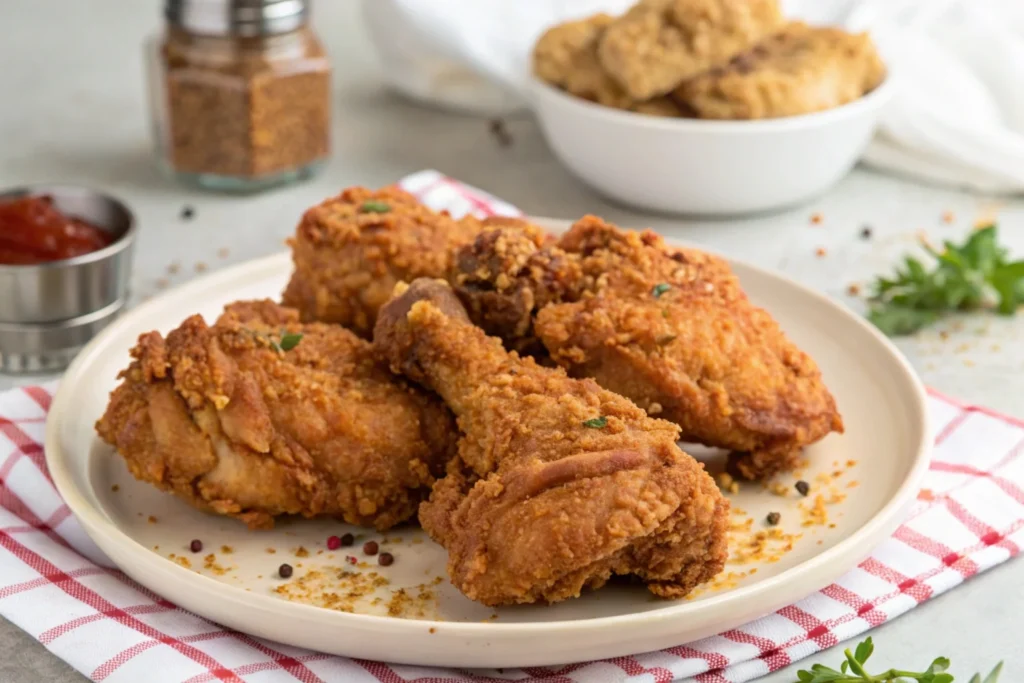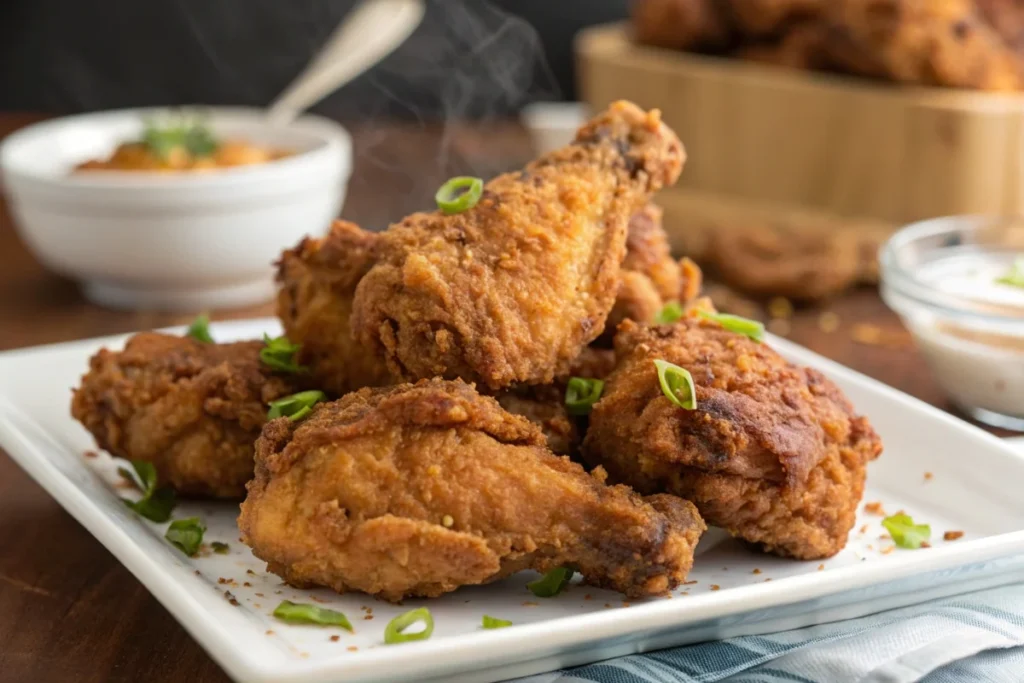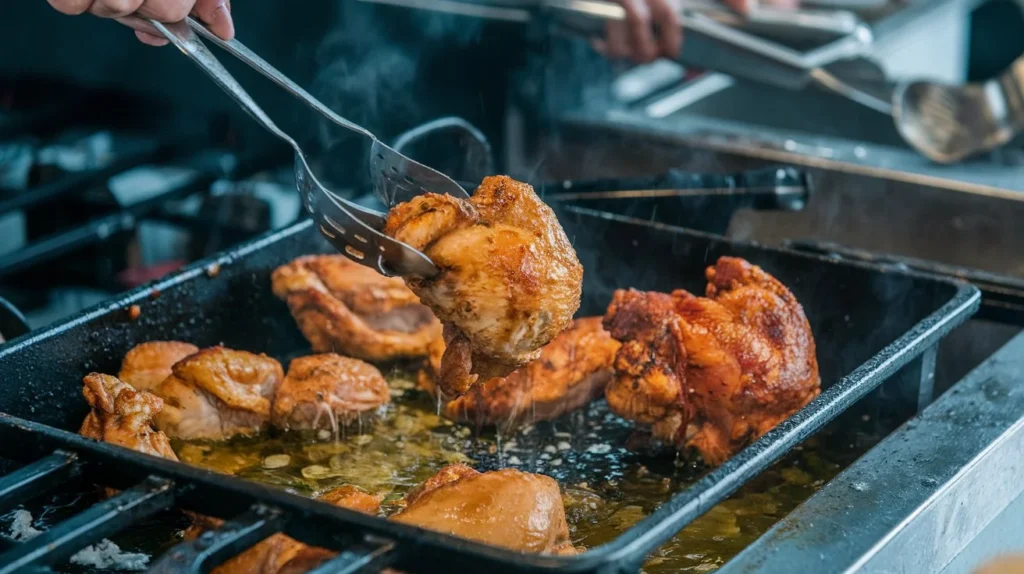Can You Fry Chicken in Olive Oil
Frying chicken is a staple in many kitchens, but can you fry chicken in olive oil? The short answer is yes, but there’s more to it than just tossing chicken into a pan of oil. Olive oil, often praised for its health benefits, can also be a flavorful choice for frying when used correctly. This article will explore how to fry chicken using olive oil, including its smoke points, health benefits, and practical techniques to get perfectly crispy results. We’ll also bust some common myths about frying with olive oil and provide expert tips to make your next fried chicken dish a success.
Introduction to Frying Chicken in Olive Oil
Understanding Olive Oil for Frying Chicken
Olive oil isn’t just for salads! It can be a delicious option for frying chicken, but knowing the right type matters. Olive oil comes in various forms, each with unique properties suitable for different cooking methods.
Types of Olive Oil
- Extra Virgin Olive Oil (EVOO): Unrefined and rich in antioxidants. Best for light sautéing due to its lower smoke point.
- Virgin Olive Oil: Less pure than EVOO but still unrefined. Slightly higher smoke point than EVOO.
- Refined Olive Oil: Processed for a more neutral taste and higher smoke point, ideal for frying.
Smoke Points of Olive Oils
Smoke point determines how hot the oil can get before breaking down. For frying chicken, the smoke point plays a huge role in both safety and flavor.
- Extra Virgin Olive Oil: 325-375°F (163-190°C)
- Virgin Olive Oil: Around 390°F (199°C)
- Refined Olive Oil: Up to 465°F (240°C)
For frying chicken, refined olive oil is often the best choice due to its stability at higher temperatures.
Health Benefits of Olive Oil for Frying
Why choose olive oil over other frying oils? The health perks are impressive.
- Rich in Monounsaturated Fats: These heart-healthy fats can help reduce bad cholesterol levels.
- Loaded with Antioxidants: Polyphenols in olive oil protect against oxidative stress.
- Anti-Inflammatory Properties: Studies suggest olive oil may reduce inflammation when consumed regularly.
Frying chicken in olive oil not only adds a rich, mild flavor but also provides healthier fat choices compared to highly processed oils like canola or vegetable oil.
Why Use Olive Oil for Frying Chicken?

So, why should you fry chicken in olive oil instead of other options?
- Healthier Option: Olive oil is packed with beneficial compounds not found in many other oils.
- Delicate Flavor: It enhances the chicken’s natural taste without overpowering it.
- Crispy Texture: When done right, chicken fried in olive oil turns perfectly golden and crispy.
Misconceptions About Frying Chicken in Olive Oil
There are many myths surrounding olive oil and frying. Let’s clear them up:
- “Olive Oil Burns Too Fast”: While extra virgin olive oil has a lower smoke point, refined versions work perfectly fine for frying.
- “Olive Oil Loses Its Nutrients When Heated”: While heating can degrade some antioxidants, olive oil remains a healthier choice than many alternatives.
Preparing to Fry Chicken in Olive Oil
Before you heat up the pan, proper preparation is key.
- Pick the Right Olive Oil: Choose refined or light olive oil for frying due to its higher smoke point.
- Preheat the Oil: Maintain a temperature between 350-375°F (175-190°C) for optimal crispiness.
- Use a Thermometer: To avoid overheating, use a kitchen thermometer to monitor the oil.
Frying Techniques Using Olive Oil for Chicken
Achieving perfectly crispy, golden-brown chicken depends on the frying technique you use. Frying chicken in olive oil can deliver exceptional results when you understand the methods and steps involved. Let’s explore the different frying techniques and how olive oil plays a crucial role.
Shallow Frying vs. Deep Frying Chicken in Olive Oil
Understanding the differences between shallow and deep frying is essential when deciding how to fry chicken in olive oil effectively.
Definitions and Differences When Frying Chicken in Olive Oil
- Shallow Frying: Chicken is partially submerged in oil, requiring flipping for even cooking.
- Deep Frying: Chicken is fully submerged, cooking evenly without flipping but using more oil.
Suitability of Olive Oil for Shallow and Deep Frying Chicken
- Shallow Frying: Works well with extra virgin or virgin olive oil due to lower heat.
- Deep Frying: Refined olive oil, with a higher smoke point, is best for deep frying chicken.
Step-by-Step Guide to Frying Chicken in Olive Oil
Follow these essential steps to achieve the perfect crispy chicken using olive oil.
Selecting the Right Olive Oil for Frying Chicken
- Extra Virgin Olive Oil: Suitable for shallow frying only.
- Refined Olive Oil: Ideal for deep frying chicken due to its high smoke point.
Preparing Chicken for Frying in Olive Oil
Proper preparation makes a difference when frying chicken in olive oil.
Marination Tips:
- Marinate with buttermilk or saltwater brine for juicier chicken.
- Add garlic, lemon juice, and herbs for extra flavor.
Breading Techniques:
- Classic Method: Coat in flour, dip in egg wash, then breadcrumbs.
- Double Coating: Repeat flour and egg steps for extra crunch.
Frying Process: How to Fry Chicken in Olive Oil Correctly
- Optimal Temperature: Maintain oil between 350-375°F (175-190°C).
- Cooking Times:
- Chicken Wings: 8-10 mins
- Drumsticks: 12-14 mins
- Thighs: 14-16 mins
- Even Cooking Tip: Avoid overcrowding the pan and flip chicken halfway when shallow frying.
Flavor Profile of Chicken Fried in Olive Oil
Frying chicken in olive oil enhances both the taste and texture of your dish.
Taste Differences When Frying Chicken in Olive Oil vs. Other Oils
- Olive Oil: Fruity, mild with a slightly peppery finish.
- Vegetable Oil: Neutral but lacks depth.
Enhancing Flavor When Frying Chicken in Olive Oil
- Add herbs like rosemary and thyme to the oil.
- Sprinkle smoked paprika, garlic powder, and black pepper for bold seasoning.
In the next section, we’ll explore health considerations and debunk common myths about frying chicken in olive oil.
Health Considerations and Myths About Frying Chicken in Olive Oil

Can you fry chicken in olive oil without compromising its nutritional value? Absolutely! Olive oil stands out as a healthier option compared to many other cooking oils, but several myths can create confusion. Let’s explore the nutritional differences, calorie impact, and scientific insights while busting common misconceptions.
Nutritional Comparison: Olive Oil vs. Other Cooking Oils for Frying Chicken
Not all oils are equally beneficial when it comes to frying chicken. Frying chicken in olive oil offers unique nutritional advantages compared to other fats commonly used for frying.
Olive Oil:
- Monounsaturated Fats (MUFAs): Comprising about 73%, MUFAs can help support heart health.
- Antioxidants: Rich in polyphenols, which protect cells from oxidative damage.
- Vitamins: Contains vitamin E and K, essential for immune support and bone health.
Vegetable Oil (Canola, Corn, Soybean):
- Often high in omega-6 fats, which, in excess, can promote inflammation.
- Minimal antioxidant content.
Coconut Oil:
- Contains around 90% saturated fats, which may raise LDL cholesterol.
- Limited antioxidant properties compared to olive oil.
Key Takeaway: Frying chicken in olive oil, especially refined olive oil, provides a healthier fat profile with antioxidants, making it a better choice than many alternatives.
Calorie Content When Frying Chicken in Olive Oil
Many people ask, Does frying chicken in olive oil add too many calories? While all frying oils increase calorie content, the type of fat used makes a difference.
- Olive Oil: ~120 calories per tablespoon, mostly heart-healthy MUFAs.
- Vegetable Oil: ~120 calories per tablespoon, but with fewer health benefits.
- Butter: ~102 calories per tablespoon, higher in saturated fats.
The trick is to fry at the right temperature (350-375°F) to create a crispy seal, which minimizes excess oil absorption.
Addressing Common Myths About Frying Chicken in Olive Oil
There are several widespread myths about frying chicken in olive oil. Let’s set the record straight with scientific insights.
Does Heating Olive Oil for Frying Chicken Make It Unhealthy?
A common misconception is that heating olive oil breaks down its nutrients and makes it harmful.
- Fact: While some antioxidants degrade under extreme heat, olive oil retains its monounsaturated fat profile and remains healthier than many oils.
- Scientific Insight: Most of the health benefits, including heart-healthy fats, remain intact even when frying chicken in olive oil.
Is Olive Oil’s Smoke Point Too Low for Frying Chicken?
Another frequent myth is that olive oil has a low smoke point, making it unsuitable for frying.
- Extra Virgin Olive Oil: Smoke point around 375°F (191°C), suitable for shallow frying.
- Refined Olive Oil: Smoke point around 465°F (240°C), perfect for deep frying chicken.
Scientific Insights: Stability of Olive Oil When Frying Chicken
Research has debunked the myth that olive oil is unstable when heated.
Studies on Olive Oil Stability at High Temperatures for Frying Chicken
A 2018 study published in Acta Scientific Nutritional Health analyzed olive oil’s heat stability:
- Olive oil showed minimal oxidation even after multiple heating cycles.
- Stability was higher than many vegetable oils like sunflower and soybean oil.
Health Implications of Frying Chicken in Olive Oil
Frying chicken in olive oil offers both taste and health advantages:
- Low Oxidation Risk: Produces fewer harmful compounds than other oils.
- Heart-Healthy Fats: MUFAs support cardiovascular health.
- Antioxidant Retention: Despite heat, olive oil retains beneficial compounds.
By choosing the right type of olive oil and controlling temperature, frying chicken in olive oil remains a nutritious choice.
In the next section, we’ll explore best practices for maintaining oil quality, preventing hazards, and proper cleanup! for maintaining oil quality and ensuring safe frying practices!
Practical Tips and Best Practices for Frying Chicken in Olive Oil
Mastering how to fry chicken in olive oil isn’t just about the cooking process—it involves properly handling and maintaining the oil to ensure safety, taste, and health benefits. These practical tips will help you maximize your oil’s quality, avoid hazards, and clean up efficiently.
Maintaining Oil Quality When Frying Chicken in Olive Oil
Using olive oil correctly and preserving its quality is essential for achieving perfect fried chicken and avoiding waste.
Reusing Olive Oil After Frying Chicken in Olive Oil
Yes, you can reuse olive oil after frying chicken, but there are limits to how many times. Repeated heating can degrade the oil’s quality and affect the taste.
Best Practices for Reusing Olive Oil:
- Strain After Each Use: After frying chicken in olive oil, filter out food particles using a fine mesh strainer or cheesecloth. This prevents the oil from turning rancid quickly.
- Limit Reuse: Olive oil can be reused 3-4 times before it starts losing its quality.
- Type Matters: Refined olive oil holds up better to repeated use due to its higher smoke point.
Using olive oil too many times for frying can lead to a breakdown in healthy fats and increase oxidation, making it less beneficial for health.
Proper Storage of Used Oil After Frying Chicken in Olive Oil
Storing used olive oil correctly ensures it remains safe and usable for future frying.
Steps for Proper Storage:
- Cool Completely: Allow the oil to cool down completely after frying chicken in olive oil before storing it.
- Use an Airtight Container: Store strained oil in a glass jar or stainless steel container to prevent exposure to air, which can lead to oxidation.
- Keep Away from Light: Store olive oil in a cool, dark place, as light and heat can speed up degradation.
By storing oil properly, you can extend its lifespan and continue to enjoy delicious fried chicken without compromising on flavor.
Safety Measures When Frying Chicken in Olive Oil
Frying chicken in olive oil is generally safe, but improper handling can lead to kitchen accidents. Follow these safety measures to ensure a smooth cooking experience.
Avoiding Oil Overheating When Frying Chicken in Olive Oil
Overheating olive oil can lead to the formation of harmful compounds and even pose a fire hazard.
Key Tips to Prevent Overheating:
- Monitor the Temperature: Use a kitchen thermometer and keep the oil between 350°F and 375°F (175°C to 190°C) when frying chicken in olive oil.
- Choose the Right Olive Oil: Refined olive oil is best for high-heat cooking as it has a higher smoke point.
- Watch for Smoke: If you notice light smoke, lower the heat immediately to prevent the oil from reaching its smoke point.
Handling Oil Spills and Splatters When Frying Chicken in Olive Oil
Hot oil splatters can cause burns or kitchen messes if not managed carefully.
Tips to Prevent Splatters:
- Pat Chicken Dry: Moisture causes splattering, so ensure the chicken is dry before frying.
- Use a Splatter Screen: Place a splatter guard over the pan to contain the oil.
- Keep a Safe Distance: Avoid standing too close to the pan while frying chicken in olive oil.
What to Do If Oil Spills:
- Turn off the heat immediately.
- Do not use water on a hot oil spill—it can cause flare-ups.
- Use baking soda or salt to absorb the spill safely.
Cleaning Up After Frying Chicken in Olive Oil
Proper cleanup ensures a safe and tidy kitchen after frying chicken in olive oil.
Effective Methods to Dispose of Used Oil After Frying Chicken in Olive Oil
Disposing of used oil properly is crucial to avoid environmental harm and clogged drains.
Do Not:
- Pour oil directly down the sink—it can cause severe plumbing issues.
Do:
- Let the Oil Cool: Allow oil to cool completely.
- Solidify and Trash: Mix with an absorbent material like coffee grounds or paper towels, then discard it in the trash.
- Recycle: Check if your local waste management offers oil recycling services.
Cleaning Utensils and Cookware After Frying Chicken in Olive Oil
Cleaning cookware after frying chicken can be easier with the right steps.
Steps for Easy Cleanup:
- Soak in Hot, Soapy Water: Let pans soak to loosen grease buildup.
- Use Baking Soda: For stubborn residue, sprinkle baking soda and scrub gently with a non-abrasive sponge.
- Rinse Thoroughly: Ensure all soap and residue are removed before drying.
Maintaining proper kitchen hygiene ensures better frying results and extends the life of your cookware.

FAQs About Frying Chicken in Olive Oil
Can I reuse olive oil after frying chicken?
Yes, olive oil can be reused up to 3-4 times if strained and stored properly.
Is extra virgin olive oil suitable for deep frying?
No, extra virgin olive oil has a lower smoke point. Use refined olive oil for deep frying.
Does frying in olive oil alter its health benefits?
Not significantly. While some antioxidants break down, it retains heart-healthy fats and remains a nutritious choice.
What are the best seasonings for olive oil-fried chicken?
Try smoked paprika, garlic powder, black pepper, onion powder, and cayenne for extra flavor.
How can I prevent chicken from becoming too greasy?
Fry at 350-375°F, avoid overcrowding the pan, and drain chicken on a wire rack.
What side dishes pair well with olive oil-fried chicken?
Garlic mashed potatoes, coleslaw, steamed asparagus, and garden salad make great choices.
Conclusion
Frying chicken in olive oil isn’t just possible—it’s a healthier and flavorful way to achieve crispy, golden perfection. By selecting the right type of olive oil, maintaining proper temperatures, and following best practices, you can enjoy fried chicken that’s both delicious and nutritious. Remember, the key to success lies in refined olive oil’s higher smoke point, careful handling, and proper oil disposal. So go ahead—give it a try for your next fried chicken night!








